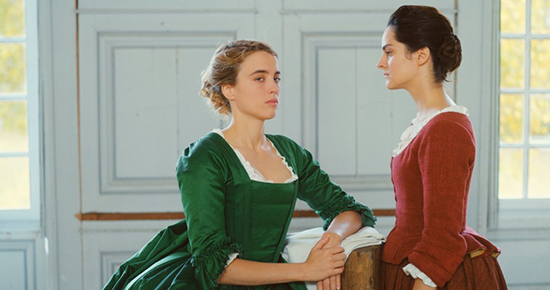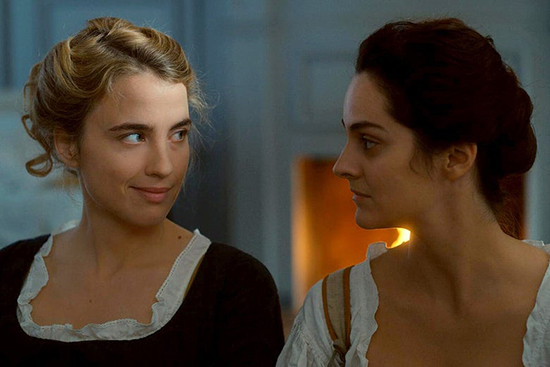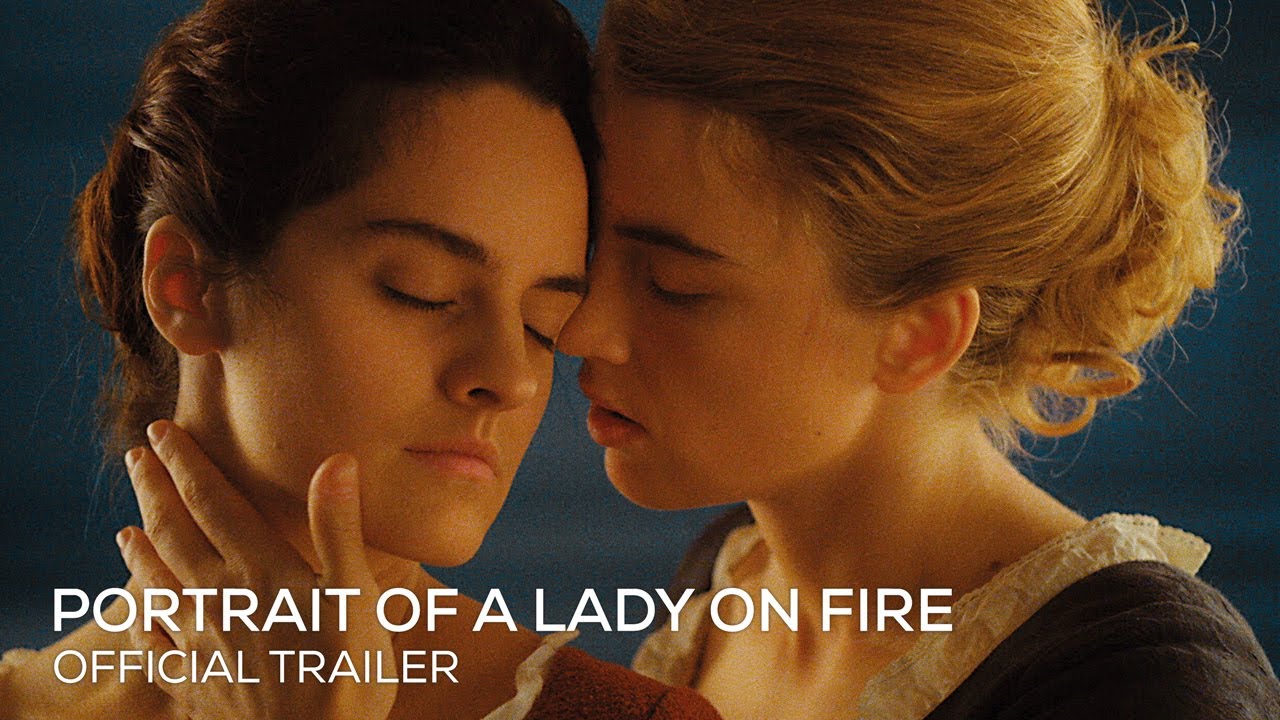The opening minutes of Portrait of a Lady on Fire feel like the safety instructions before a plane takes off. “Take time to look at me,” advises Marianne (Noémie Merlant), a tutor posing in front of her life-drawing students. Which, in turn, is a request to the viewer. Unhurried and meditative, Céline Sciamma’s lesbian love story communicates its simmering romance through subtle glances and piercing stares. It is, then, a slow-burn lesson in the art of seeing.
Set in the late 18th century, Sciamma’s fourth feature is, as the French writer-director has joked, structured like Titanic. Marianne spots a painting of what is hinted to be a former flame, and the image triggers a boat-related flashback. In this reminiscence, Marianne traverses rocky waters to reach the remote island of Brittany for a peculiar freelance gig: secretly painting a young loner, Héloïse (Adèle Haenel). In this pre-Tinder age, Héloïse’s mother (Valeria Golino) plans to lure a wealthy Milanese husband for her daughter by sending out a flattering portrait. As Héloïse refuses to pose for pictures, Marianne must befriend her reluctant subject and construct the painting in private from memory. It’s the kind of life drawing that requires drawing from life experiences.
Sciamma first made a splash in 2007 with her directorial debut, Water Lilies. In that coming-of-ager, Haenel co-starred as Floriane, the go-getting, flirtatious captain of a synchronised swimming team; a romantic target of boys and girls alike, Floriane divides her time between dancing at parties and dancing in the pool. However, Héloïse is an introvert in constrictive corsets who gazes at the surrounding sea and comments, “I don’t know if I can swim.”
“In France – I don’t know what it’s like here – but I’m known in arthouse cinema for very much being explosive,” Haenel tells me, referencing her roles in critical hits like 120 BPM, House of Tolerance and Suzanne. So the role of Héloïse, she continues, was written specifically for her as a palette-cleanser. “I’m always yelling, fighting, or whatever. It’s a cliché. We wanted to mute this thing, and show something that would be more naked and more true.”
When I meet Haenel and Merlant in a Soho hotel, it’s a few hours before Portrait of a Lady on Fire dazzles a sold-out crowd at the London Film Festival. The pair’s responses – sometimes Haenel will translate for Merlant – are thoughtful and pensive, as if they’re still processing their characters’ journeys. Or perhaps they’re wary of ruining the mystery. “It’s like when you’re in a museum,” Merlant says. “You have to talk about a painting in order to understand the painting. But sometimes I don’t like knowing the secrets of a painting – I want to invent my own story.”
The film is also a lesson in the art of hearing. Sciamma’s movies are typically soundtracked with pop tunes – most memorably Rihanna’s “Diamonds” in Girlhood – but Portrait of a Lady on Fire contains only two moments of music, both of which are diegetic. Subsequently, the forbidden bond between Héloïse and Marianne is heightened by the shared silences. As for the soundscape, it’s ASMR paradise: scraped paintbrushes, a crackling fireplace, creaky floorboards, and so on. The sheer number of ASMR videos about getting your portrait taken (this one by Gibi, the Sciamma of the ASMR world, has 4.5 million views) speaks – or whispers – volumes about the scenario’s charged undertones. Everyone wants to feel seen.
“It was about creating a kind of silence where the action would take place,” Haenel says. “Céline’s movies are about creating a focus. For example, there’s not much music. So when you hear the two pieces, it takes up a lot of space. It’s the same for gestures, it’s the same for objects, it’s the same for everything. It creates an atmosphere where a slight touch would be very erotic, and a look would be very erotic.”
As Héloïse isn’t as verbal as, say, Floriane from Water Lilies, her eye movements are crucial to deciphering the character. Often, she will stand or sit completely still – except for two darting pupils. “There’s a lot of joy in restraint,” Haenel continues. “It’s not about letting the emotions explode. We’re trying to create a new emotion for the audience through the rhythm and exchanges. It’s another way to focus. We’re not trying to reach the correct emotion. We’re trying to give the audience its own specific emotion.”

That aforementioned restraint pays off when Marianne and Héloïse start listing the idiosyncrasies they’ve detected in each other. “When you’re annoyed, you don’t blink,” Marianne says. “When you don’t know what to say, you touch your forehead,” Héloïse responds. The examples go on. When a painter gazes directly at her subject, the subject stares back just as intensely.
“Actually, it was written differently,” says Merlant, who I notice will touch her forehead when my questions are too abstract. “We’d done a lot of the shoot already, but we were doing these expressions, and so we changed those lines.”
“Those are the only lines we changed in the whole film,” Haenel adds. “We didn’t try to put those gestures into the movie. But we saw it. It was true, and it was happening. It’s the miracle of cinema.” She apologises for her English and asks if I speak French. Unfortunately, I don’t. “It’s about believing in the power of cinema. This is what makes the movie unique. Céline has her own way of telling a story, and she doesn’t follow any rules.”
Sciamma, thus far, has specialised in coming-of-age movies. Not just her three prior directorial features (Water Lilies, Tomboy, Girlhood) but also in her screenwriting credits (Being 17, My Life as a Courgette). Portrait of a Lady on Fire, though, by its nature, is a more mature tale of identity, and it can also feel like a self-portrait. Before Marianne can paint, she must establish the correct mood, lighting, and architecture of the room. The artwork, Marianne explains, will document this single moment for eternity. So is this a film about filmmaking? After all, movies are – to quote Taika Waititi – 24 paintings per second.
“It’s about the work, rather than the result of art,” Haenel says. “It’s about collaboration. It’s about the patience of the work, and sharing ideas, and two people in a room trying to figure out a solution. It’s also a film about love. It’s intricate. Love is also like art. It’s to do with discussions, with sharing your mind, with sharing ideas, with sharing fantasies.”
“When you create love or art, you create a dialogue between two or three people,” Merlant adds. “This movie is about taking your time. Achievements come because there is a place for the imagination.”
After Portrait of a Lady on Fire premiered in Cannes, the two words most uttered by admirers is “page 28”. Héloïse and Marianne, as a sort of inside joke, use the page number to discreetly communicate to one another. Fans have tattooed “p. 28” on their bodies as a tribute. Have the actors ever inserted secret messages into their films, too?
“No!” Haenel remarks, peeved at the suggestion. She doesn’t blink. “Like for friends?!”
I guess so.
Haenel pauses. “Well, in this film, there is this conception that we put in a hidden message. But I think what interests us is to create a mystery behind the image [of page 28]. There was an answer for why it’s page 28. We explained why: because it’s my age.” When they shot the exchange, the dialogue felt wrong. “So we cut the lines, because we wanted to create a mystery for the audience.” (So now you’ve read it, try to forget it.)
At Cannes, Portrait of a Lady on Fire competed for the Palme d’Or alongside Mektoub, My Love: Intermezzo, a critical disaster by Abdellatif Kechiche that’s since been dubbed “the butt movie” for its plot – or lack thereof. Reviewers thus described Sciamma’s movie – particularly its delicate, romantic sex scene – as a corrective for Kechiche’s misogyny. However, in a September interview with the French publication So Magazine, Sciamma defended Kechiche’s artistic vision and, per IndieWire’s translation, commented: “It was extremely interesting to have both our films in competition. Thanks to Kechiche’s film, and to Portrait, the French critics were faced with questions of the male and female gaze… It is completely stupid to think you can only love one at the expense of the other.”
“It’s giving too much importance to Mektoub,” Haenel says of the comparisons. “It’s us wanting to do something that really belongs to us. If someone wants to make that link, they can. I think that what Céline said is what we said about giving the keys to the audience to ask about the meaning of a frame, of an image, of the movie. Our movie is the collaborative one where we share opinions. And Mektoub is the typically male gaze one.
“Then there’s another piece of art with [Kechiche’s Blue Is the Warmest Colour]. For example, we can compare the sex scenes. Personally, when I watch the sex scene in our movie, I think, ‘This is great. This is a collaboration. No one is giving something she doesn’t want to give.’ It’s different.”
In 2018, Sciamma and Haenel were among the founding members of the “5050 Pour 2020” (“50/50 by 2020”) initiative in France. The movement’s website lists its two main aims: “Challenge our cultural institutions” and “Create an observatory to monitor equality in our industry”. A month after our interview, Haenel will accuse the director Christophe Ruggia of sexually harassing her when she was 12 years old. In Portrait of a Lady on Fire – which you sometimes forget is set in the 18th century – Marianne comments on how the business is weighted against female artists. Women aren’t allowed to paint male nudes, Marianne explains, and that it’s “mostly to prevent us from doing great art”. Many real-life artists from that period were overlooked or stricken from records – within the film, Marianne submits a painting under her father’s name.
Merlant notes that they had a 2019 and 2020 audience in mind. “The costumes had pockets,” she says. “I had a coat that you could wear today. And you forget [about the era] when you play it – you just play it as if they’re alive. They were fighting for women’s rights, and these women painters were erased from history. So it feels really contemporary and modern. We were inventing something right now, in the present moment, and all the feelings, like the love story, and all this stuff. It’s real, and here, and now.”
The pair have to leave for a magazine shoot, but it isn’t possible to end the interview without asking about, well, the end. Without giving away too much, it was the third of three takes, and the kind of bravura acting in which you ask how many takes it required. “The scene is very much to do with how we built the emotions before in the movie,” Haenel explains. “Because we had this delay – a delay with the love, and the sharing of emotion. There’s a final explosion. It’s harvested for the entire film, because we had this restraint.
“It’s something we built together.” Haenel then nods towards Merlant. “I embodied it, but we built it together.”
Portrait of a Lady on Fire is out in UK cinemas and on Curzon Home Cinema on February 28



